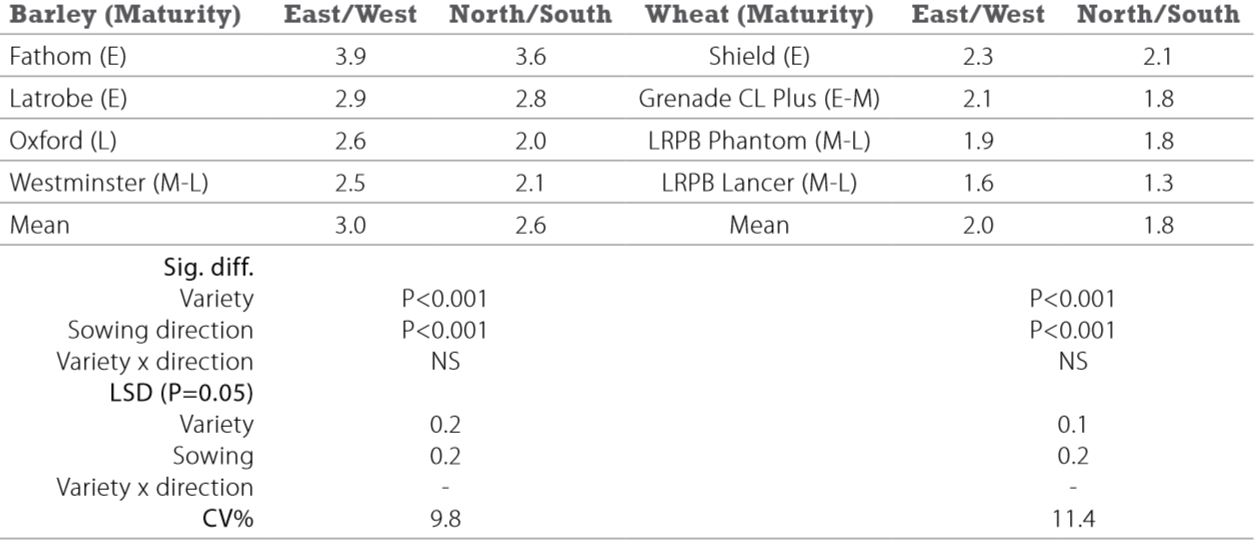In 2014, BCG conducted a trial at the Horsham site to investigate whether sowing direction influenced grain yield. After initial analysis of the results, it was reported that sowing in an eastwest direction had a positive influence on yield. However, further statistical analysis undertaken since the publication of this report has revealed the yield increase was not significant.
What was presented in 2014
In 2014 the initial key finding was yield could be significantly increased by sowing east to west. It was noted the trial was a complete randomised block design. See 2014 results as presented in Table 1.
Table 1. Mean barley yield (t/ha) for each variety and sowing direction (complete randomised block)
Statistical discrepancies
Given this trial was to be repeated in 2015, time went into developing the second year of the trial, in an effort to choose crop species that were of interest and at the same time, allow ease of spraying in close proximity. During this process, it was realised that the 2014 trial design was in fact a split plot design, as sowing direction makes it nearly impossible to completely randomise the trial. In simple terms, what this does is increase the chance of spatial variability in the trial. As such, the underlying statistics were needed to account for this increased risk by adding an extra layer of analysis.
When the results were analysed using this method (split plot design) a different outcome was reached (Table 2). It can be seen that while the means of the treatments have not changed using this method of statistical analysis, their significance had. Varieties still had notable differences, but the importance of sowing direction was lost as a result of increasing the spatial background noise. Note: All P and LSD values included in this table.
Table 2. Mean barley yield (t/ha) for each variety and sowing direction (split plot design).
What happened in 2015?
In 2015, as a result of strong member interest, the plots were re-sown on 23 May to only two crops, wheat and faba beans. Given the decile 1 conditions and late sowing due to the unfavorable start, the faba beans failed and no results were obtained. The wheat (Elmore CL) made it to harvest, producing an average trial yield of 0.35t/ha, but it was found that there were no differences in sowing direction in terms of yield, or any quality parameters (Table 3).
Results were analysed taking into account the 2014 crop/variety for differences this may have caused in the following crop. There was no significant difference as a result of the 2014 crop/variety or any interaction with sowing direction.
Comparing yields this low is not ideal, as it becomes difficult to pick up differences, and also if spatial variability exists, it can be amplified under poor seasons, creating high levels of variation in the trial.
From two years of trial work, when analysed using split plot method, it was found that sowing direction has no influence on yield in the seasons studied. This also aligns with the work carried out in the overdependence on agrochemicals work carried out in 2015 (‘Using sowing direction and row spacing for weed management in the Mallee’, pp. 117), which also demonstrated no influence on just yield from sowing direction. The ability to utilise sowing direction for the purpose of weed management in a low rainfall environment is still under review.
Table 3: Mean wheat yields, test weight, protein and screenings for sowing direction.
What have we learned?
After seeing the results of the 2014 sowing direction trial analysed in two ways it is clear that it is not good enough to look only at the yield results. The statistics used need to be considered as they give an account of how much variation is in the trial (as can be indicated by CV values and the way the trial should be analysed) and also whether the trial itself is statistically valid to begin with. A simple error in any of these areas can change a result completely, as occurred in this instance.
When analysing trial results, always have in the back of your mind some key thoughts or questions. Was the trial replicated sufficiently or at all? Is the trial located in a uniform location with minimal effects from considerations such as soil type, slope, old headlands, weedy patches and so on? Was the trial designed and analysed correctly?
It is also important to look at work over more than one season, and in some cases, in more than one environment, because changes should not be made unless results are repeatable. If a result occurs over multiple environments and multiple seasons it is less likely to be a result of chance, and more likely to have some real meaning, although each trial needs to be considered on its own merits. Remember, very poor seasons are more likely to produce highly variable results that are harder to tease apart.
BCG apologises for the error in analysis which was published in the 2014 BCG Season Research Results.



